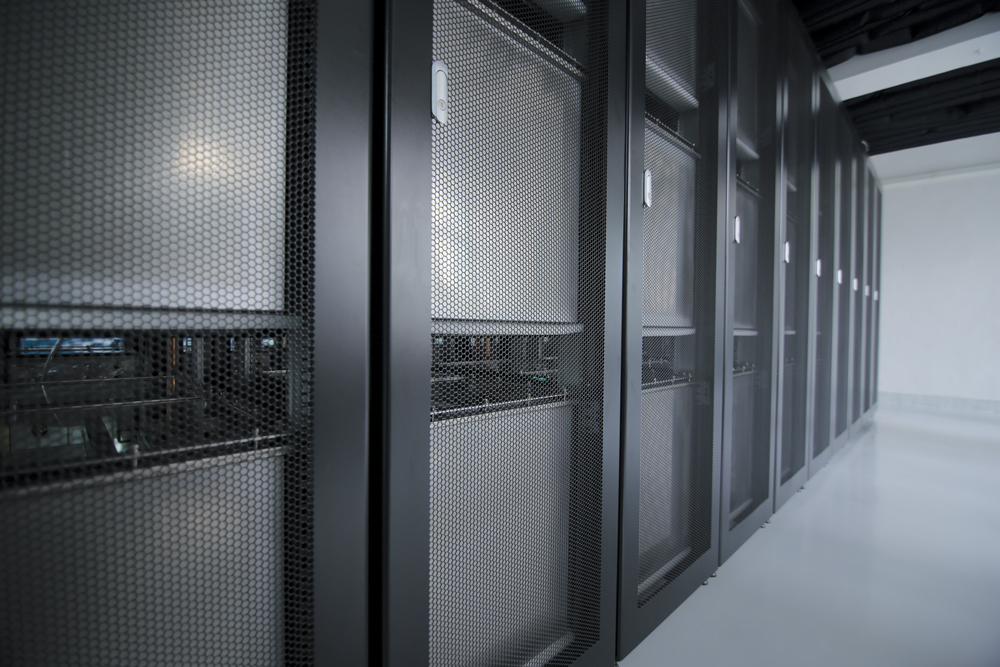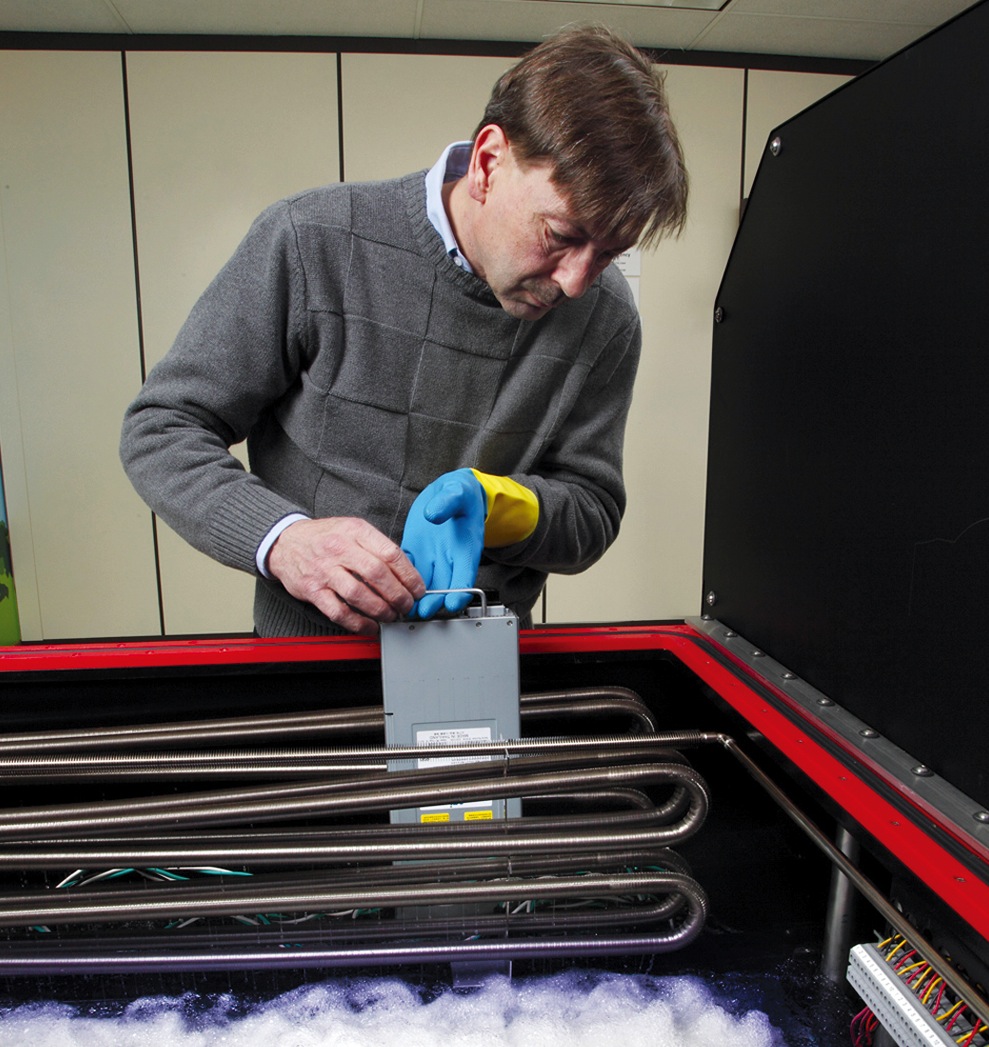In the rush to slash energy consumption in power-hungry data centers, design teams, equipment manufacturers, and tech companies have been developing clever, low-energy cooling solutions—from Facebook’s open-rack server setup with exposed motherboards, to Skanska’s eOPTI-TRAX liquid refrigerant coil system, to Google’s evaporative cooling schemes.
Solutions like these have helped data center facility operators achieve unprecedented energy performance levels, with power utilization effectiveness (PUE) ratios dipping below 1.10 in some instances. This means that less than 10% of the total energy consumption in a facility is attributed to noncomputing functions, such as air-conditioning and lighting.
Now, a new technology promises to push the limits of data center energy efficiency even further. Called immersive cooling, it uses a liquid instead of air to cool the servers. LiquidCool Solutions, Green Revolution, and 3M are among the pioneers of this technology. Each system works a bit differently, but the basic idea is to submerge the motherboards in tanks filled with nonconductive fluid, which absorbs the heat generated by the processors.
LiquidCool Solutions, for example, uses an enclosed server module and pumps dielectric fluid through the server enclosure. Green Revolution uses a tub full of dielectric oil and circulates the liquid through the tubs. 3M also uses the tub approach, but the fluid boils and then is condensed to reject the heat.
By using liquid-based cooling at the server level, the need for air-conditioning is greatly reduced, or even eliminated in some climates. The same goes for traditional HVAC equipment and systems—chillers, fan units, raised floors, and so on.

The Allied Control 500 kW immersion-cooled data center in Hong Kong is capable of delivering a PUE of just 1.02. The standard, 19-inch server racks use 3M Novec Engineered Fluids to enable tight component packaging for greater computing power in less space, according to Allied. Its open-bath design permits easy access to hardware and eliminates the need for pressure vessel enclosures and charging/recovery systems. PHOTO: COURTESY ALLIED CONTROL
“In most parts of the world, compressorized cooling would not be required with immersive cooling, since the liquid temperatures can be at a level where direct heat rejection using outdoor condensers or cooling towers would be sufficient,” says Thomas Squillo, PE, LEED AP, Vice President with Environmental Systems Design, who is currently researching the technology for the firm’s data center clients. “The fan energy is also eliminated, both in the HVAC system and in the server itself. Fluid pumping energy is very low.”
Other advantages of the cooling technology, according to Squillo:
• Increased performance and service life of the computer chips by eliminating heat buildup and problems related to contaminated air and dust.
• Ability to deploy data centers in extremely harsh environments without greatly impacting energy performance.
• Potential construction cost savings by downsizing or eliminating traditional HVAC systems.
Other than a few pilot projects, including a Bitcoin mining data center in Hong Kong and a Lawrence Berkeley National Laboratory-led installation in Chippewa Falls, Wis., immersive cooling technology is largely untested. A year into the Bitcoin pilot, the data center operator reported a 95% reduction in cooling costs.
AEC professionals are starting to realize the potential for immersive cooling, especially for high-performance computing centers and consolidated, high-density data centers.
“Large data centers that have many homogenous machines at high density—like those operated by Internet and cloud providers—are a good application,” says Squillo. “Small footprint and minimal energy use are very important due to the volume of servers. These can be deployed in remote areas where space and energy are cheap, but where air quality may be a concern, without having to worry about the data center air.”
TRICKY DESIGN CONSIDERATIONS
Before the technology can be implemented, says Squillo, several nettlesome design factors specific to immersive cooling have to be addressed:
• Piping distribution to the racks and cooling units requires redundancy and valving to accommodate equipment maintenance without disrupting server performance.
• Additional equipment and space are needed to drain fluid from the tanks for server maintenance.
• Local code requirements may limit the amount of fluid that can be stored in a single room.
• For the foreseeable future, it’s unlikely that a large data center would be 100% liquid-immersion cooled. This means provisions will have to be made for both air- and liquid-cooling systems, which will require additional space in the data hall and mechanical room.
“I think that some form of this technology will definitely be the direction the data center market will take in the future,” says Squillo. “The market just needs to mature enough for owners to trust the technology and demand servers that are designed for a particular type of liquid cooling. In the short term, I see large companies and server manufacturers doing small-scale installations to test the concept, before wanting to implement it at a large scale.”
Related Stories
Affordable Housing | Apr 1, 2024
Biden Administration considers ways to influence local housing regulations
The Biden Administration is considering how to spur more affordable housing construction with strategies to influence reform of local housing regulations.
Affordable Housing | Apr 1, 2024
Chicago voters nix ‘mansion tax’ to fund efforts to reduce homelessness
Chicago voters in March rejected a proposed “mansion tax” that would have funded efforts to reduce homelessness in the city.
Standards | Apr 1, 2024
New technical bulletin covers window opening control devices
A new technical bulletin clarifies the definition of a window opening control device (WOCD) to promote greater understanding of the role of WOCDs and provide an understanding of a WOCD’s function.
Adaptive Reuse | Mar 30, 2024
Hotel vs. office: Different challenges in commercial to residential conversions
In the midst of a national housing shortage, developers are examining the viability of commercial to residential conversions as a solution to both problems.
Sustainability | Mar 29, 2024
Demystifying carbon offsets vs direct reductions
Chris Forney, Principal, Brightworks Sustainability, and Rob Atkinson, Senior Project Manager, IA Interior Architects, share the misconceptions about carbon offsets and identify opportunities for realizing a carbon-neutral building portfolio.
Reconstruction & Renovation | Mar 28, 2024
Longwood Gardens reimagines its horticulture experience with 17-acre conservatory
Longwood Gardens announced this week that Longwood Reimagined: A New Garden Experience, the most ambitious revitalization in a century of America’s greatest center for horticultural display, will open to the public on November 22, 2024.
Office Buildings | Mar 27, 2024
A new Singapore office campus inaugurates the Jurong Innovation District, a business park located in a tropical rainforest
Surbana Jurong, an urban, infrastructure and managed services consulting firm, recently opened its new headquarters in Singapore. Surbana Jurong Campus inaugurates the Jurong Innovation District, a business park set in a tropical rainforest.
Cultural Facilities | Mar 27, 2024
Kansas City’s new Sobela Ocean Aquarium home to nearly 8,000 animals in 34 habitats
Kansas City’s new Sobela Ocean Aquarium is a world-class facility home to nearly 8,000 animals in 34 habitats ranging from small tanks to a giant 400,000-gallon shark tank.
Market Data | Mar 26, 2024
Architecture firm billings see modest easing in February
Architecture firm billings continued to decline in February, with an AIA/Deltek Architecture Billings Index (ABI) score of 49.5 for the month. However, February’s score marks the most modest easing in billings since July 2023 and suggests that the recent slowdown may be receding.
Cultural Facilities | Mar 26, 2024
Renovation restores century-old Brooklyn Paramount Theater to its original use
The renovation of the iconic Brooklyn Paramount Theater restored the building to its original purpose as a movie theater and music performance venue. Long Island University had acquired the venue in the 1960s and repurposed it as the school’s basketball court.

















